How to look for records of... Intellectual property: patents of invention
How can I view the records covered in this guide?
How many are online?
- None
Contents
- 1. Why use this guide?
- The National Archives or the British Library?
- 2. The patenting process and the records it produced
- 3. Finding patents of invention 1449-October 1852
- 4. Finding specifications for patents granted up to October 1852
- 5. Other patent records
- 6. Early patents of invention, with no specification
- 7. Records after October 1852
- 8. Scottish patents up to October 1852
- 9. Irish patents up to October 1852
- 10. Further reading
- Appendix 1: Division codes in C 54
- Appendix 2: Finding aid locations in the Map and Large Document Reading Room
1. Why use this guide?
The National Archives has records of patents of invention for England and Wales dating from between 1449 and October 1852, as well as related records including technical specifications. For patents from October 1852 onwards, all enquiries should be directed to the British Library.
Up to October 1852 the Court of Chancery was responsible for safe-guarding intellectual property rights in England and Wales, issuing and recording patents of invention and the related records. The National Archives holds the records of Chancery, where the original enrolments of patents of invention (see 2.1) and their technical specifications (see 2.2) are stored separately on rolls of parchment. This guide explains how to find the records of original, enrolled patents and their specifications, which sometimes include colour drawings.
To find and use these records it will be necessary to visit the National Archives. The records themselves are on rolls of parchment and locating them depends on using a number of index volumes in our Map and Large Document Reading Room.
Consult our guide to registered designs for advice on design copyright protection, a process which was used for protection of utility designs.
Use our guides to research and development in the Army, Royal Navy or Royal Air Force for advice on finding other records of military inventions and technical research.
The National Archives or the British Library?
The British Library holds copies of the patent records held at the National Archives, and indexes to them, which were created when the Patent Office took over responsibility for registering patents in October 1852.
The Patent Office printed and published patents from 1617 up to 1852, along with typed transcriptions and engraved drawings of any specifications .
The indexes created provide a reference number and date leading to copies of patents and specifications. At the British Library, these can be searched on an electronic database.
The indexes at The National Archives identify the roll of parchment which contains either the patent, or its specification, but do not always identify where on the roll it may be found. Regnal years are used for the date of the close rolls until 1837, from 1838 calendar year is used. The rolls themselves are quite large and difficult to handle, so it may be a lengthy search to find the patent you are looking for and a separate lengthy search to find the specification.
If you are not committed to finding the original record of a patent, it is a great deal easier to find the 19th century copies of patents at the British Library than among Chancery records at The National Archives.
See the British Library help page Find early British patents for more information.
Read the blog Patently obvious: Tracing the inventions of William Henry Fox Talbot, photography pioneer to see a step by step example of a search among records at The National Archives.
2. The patenting process and the records it produced
Inventors can get an exclusive right to manufacture their own inventions for a limited period. The state issues ‘letters patent of invention’ and enrols them to record this right. Initially, the inventions were enrolled but not described in much detail. Later, they came to be described in increasing detail until this became routine. From 1617, specifications (providing full working details of the invention) began to be enrolled in a different place, after the issue of the patent. By 1734, patentees were obligated to submit a specification but this could be up to several months after a patent was granted. Patents could be enrolled by any of a number of officials of Chancery but were recorded on Patent Rolls (C 66). Specifications were submitted to one of three Chancery offices and were enrolled in Chancery Close Rolls (C54), Rolls Chapel Specification Rolls (C 73) or Petty Bag Office Specification Rolls (C 210).
2.1 Patents of inventions
The patent itself contains the formulaic text for the application of patents of invention. Typically this records:
- Name of inventor
- Monarch granting the letters patent
- A short description of the invention
- A declaration that it is unique
- Where the patent applies
- How long it is valid for (14 years)
- An assurance that the Patent protects the grantee
The National Archives holds the original enrolments on parchment. For instructions on finding them, see section 3.
The National Archives does not hold the parchments given to English patentees at grant.
2.2 Specifications of inventions
The specifications contain manuscript descriptions of the invention and sometimes illustrations engraved on vellum. They were also enrolled, but separately to letters patent. The illustrations are often detailed, with shading and colour.
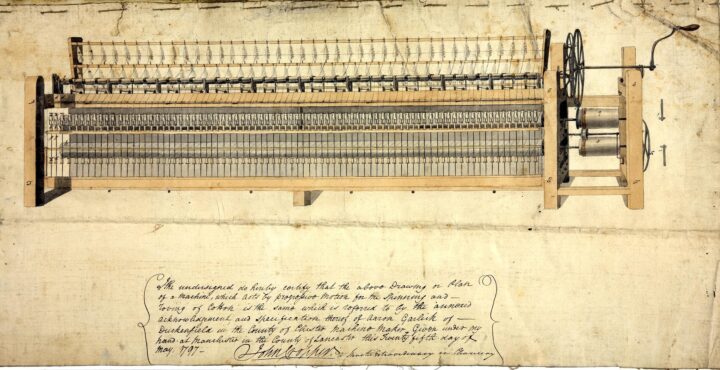
Drawing from a patent specification submitted by Aaron Garlick for a machine for spinning and roving cotton (1797). Catalogue reference: C 210/54
3. Finding patents of invention 1449-October 1852
Step 1: Find an entry in the published indexes
To identify records, you will need to find the patent’s number (called ‘progressive number’ in the Bennet Woodcroft index) and year in printed indexes held at The National Archives, the British Library and in several reference libraries. These indexes were first published in 1854 by Bennet Woodcroft, the first clerk to the commissioners of patents, as a six-volume work called Patents of Invention: from March 2, 1617 (14 James I) to October 1, 1852 (16 Victoriae).
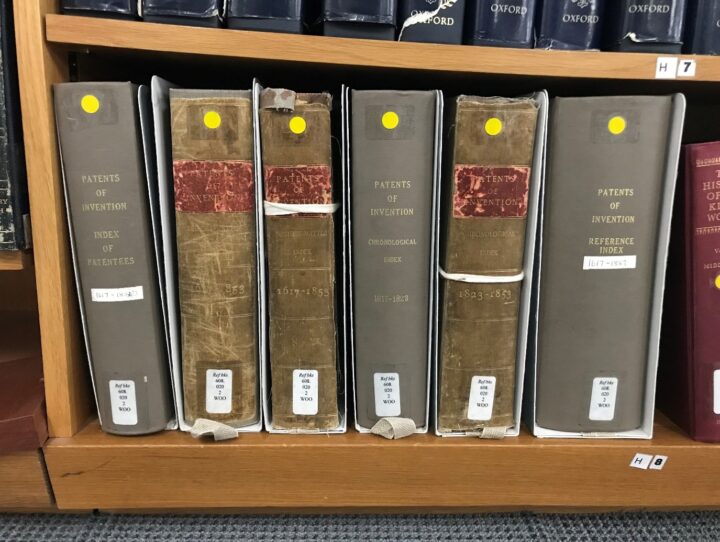
Bennet Woodcroft’s printed indexes to patents of invention in The National Archives Reading Room.
The indexes are arranged in four sequences:
- Index of patentees
- Subject-matter index (in two volumes)
- Chronological index (in two volumes)
- Reference index
Having found the patent number and the year (for example, ‘Electric batteries’, patent number: 12,697, year: 1849), you can search for the original documents held at The National Archives or a printed version at the (for advice on this you will need to contact the British Library itself).
Step 2: Move from the published indexes to the printed indexes (in C 274)
Consult the printed annual calendars (arranged by regnal years) held in the reading rooms at The National Archives. They are identified by the series reference C 274.
Search for the year you found in the published indexes at Step 1 (you may need to convert the year and month to a regnal year) and then, in the respective year, search for the inventor’s name. The calendars usually have a kind of index at the back, or the entries are arranged by initial letter of surname.
Step 3: Convert the printed index reference (in C 274) to a patent roll reference (in C 66)
Patents of invention are enrolled, along with many other types of letters patent, in the patent rolls in C 66.
Most of the entries in the printed indexes in C 274 have been marked up with the modern C 66 reference. If not, you will need to search in C 66 in our online catalogue for the ‘part number’ noted in C 274. This will provide the C 66 reference with which you can order the respective patent roll.
4. Finding specifications for patents granted up to October 1852
Specifications were enrolled separately to letters patent and could be enrolled some months after the patent. They continued to be enrolled in Chancery records up to October 1852 when the Patent Office took over. The Enrolment Office continued to enrol specifications on close rolls up to 1853, for patents registered before October 1852.
Until 1734, there was no obligation for patentees to submit a technical description or drawing to accompany their application. From this date onwards, specifications were required and patentees had several months to submit these after the patent was sealed. They could be enrolled in any one of three Chancery offices:
- Enrolment Office
- Petty Bag Office
- Rolls Chapel
Each office has its own separate finding aids and search instructions. To search for a specification, you will need to consult the Bennet Woodcroft indexes (detailed in section 3.1) and indexes and calendars in the reading rooms at The National Archives.
Start by consulting the Bennett Woodcroft ‘Index of Patentees’ (Alphabetical Index). This has been marked up with the modern references for some specifications. If so, you can search for these references in our catalogue.
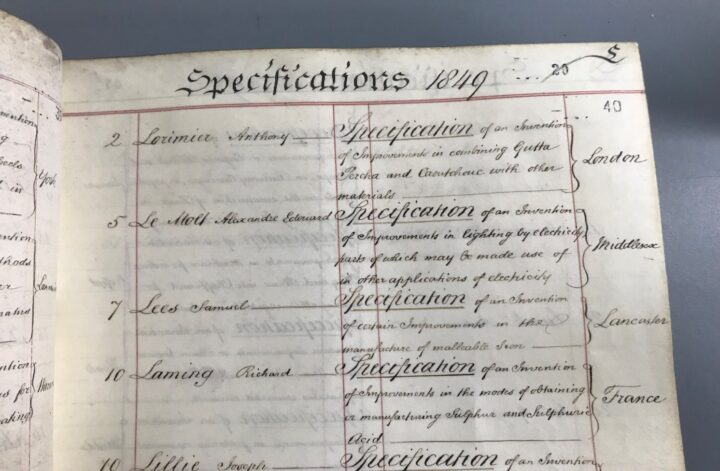
Specifications listed in index labelled ‘Refers to C 54, vol 161’, Specifications 1848-1853, Enrolment Office, Chancery (C 275/207)
4.1 Specifications, 1617-1852
If you do not find a reference annotated in the ‘Index of Patentees’, take the number in bold print from the ‘Index of patentees’.
Look for this number in the Woodcroft ‘Reference Index’. This will give you the name of the office of Chancery the specification was enrolled in.
Use the instructions for each office below, which refer to indexes and calendars in the reading rooms.
You will also see other publications listed alongside the name of Chancery Office. Specifications were circulated in various technical magazines and periodicals, often in an abridged form. These publications are not stored at The National Archives. They can be found at reference libraries and sometimes online. It is also noted where specifications were not enrolled.
4.2 Enrolment Office, 1617-1853
Specifications continued to be enrolled in the Enrolment Office until 1853, they are found on the Close Rolls in record series C 54.
On the open shelves in the reading rooms, consult the three indexes labelled C 275/209-211 which list specifications with the year, type number and division letter of the Close Roll on which they were enrolled. They are arranged in three volumes:
- C 275/209 – 1617-1826
- C 275/210 – 1826-1845
- C 275/211 – 1846-1853
Each volume is arranged chronologically by year and alphabetically by first letter of the surname of patentee within each year. Specifications were enrolled after the patent, so you may need to look at entries under later years. Depending on the date of the specification, search in Discovery in series C 54 and in the relevant year, using the details from the relevant entry:
- From 1617-c.1675 – search for the part number (P)
- From c.1675-1842 – search for the number (type number) and division letter
- From 1842-1849 – search using ‘specification’ and the ‘P’ number (corresponds to ‘type number’ in Discovery)
For example, the entry in the image below for Fred A Glover, has the type number 12, division E and year 1840, a search gives this result, the Close Roll reference is C 54/12315.
For more information about the letter codes in the C 275 index and in C 54, see appendix 1.
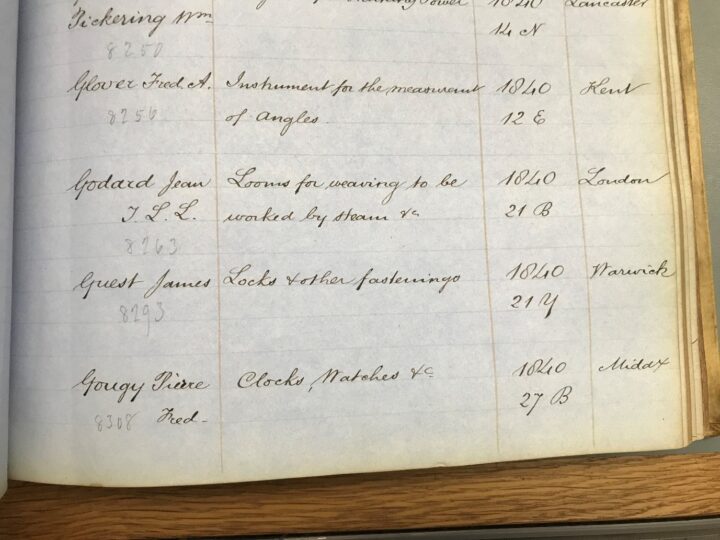
Specifications listed in C 275/210, Enrolment Office index (1826-1845). Some entries in the indexes have the progressive number marked up in pencil. The letters in the penultimate column denote geographical divisions that applied to the enrolment of Close Rolls.
4.3 Petty Bag Office, 1709-1852
Specifications enrolled in the Petty Bag Office are found in record series C 210.
The alphabetical index has been marked up with all the modern references to C 210.
Specifications are also listed by date in two volumes labelled ‘Refers to C 210, vols 1-2’. Volume 2 contains an index of names (alphabetical, by first letter only) in three sequences to match the three sections (‘calendars’) of the lists. Put C 210 in front of the ‘part’ number to get a modern reference.
4.4 Rolls Chapel
The ‘Reference Index’ lists ‘Rolls Chapel’ for specifications enrolled in the Rolls Chapel but also for some that were enrolled on the Close Rolls (because these were housed in the Rolls Chapel).
Specifications listed as ‘Rolls Chapel’ in the index are therefore found in records of the Master of the Rolls and Rolls Chapel, in C 73, and records of the Enrolment Office, in C 54. Follow the procedure under Indexed as “Rolls Chapel”.
If you see ‘Rolls Chapel Reports’ listed, note the number of the report and page number and follow the procedure under the heading Roll’s Chapel reports.
Indexed as “Rolls Chapel”
If you find ‘Rolls Chapel’ listed next to a patent in the ‘Reference Index’, consult the volume in C 275 labelled ‘Refers to C 54 etc., vol 160’. The volume is divided into two parts and you may need to look within both:
- Pages 2-77 refer to specifications on the Specification Rolls (C 73)
- Pages 78-259 to specifications on the Close Rolls (C 54)
If you find the entry in the Specification Rolls section, put C 73 in front of the part number to get the modern reference, e.g. C 73/127 . The number in the first column indicates the order of the specification on the roll.
If you find the entry in the Close Rolls section, search in C 54 using the part and date to find the reference. Again, the number in the first column shows where the specification appears on the roll.
Some drawings have been extracted from C 73 – see references: C 73/81/1 and C 73/81/2
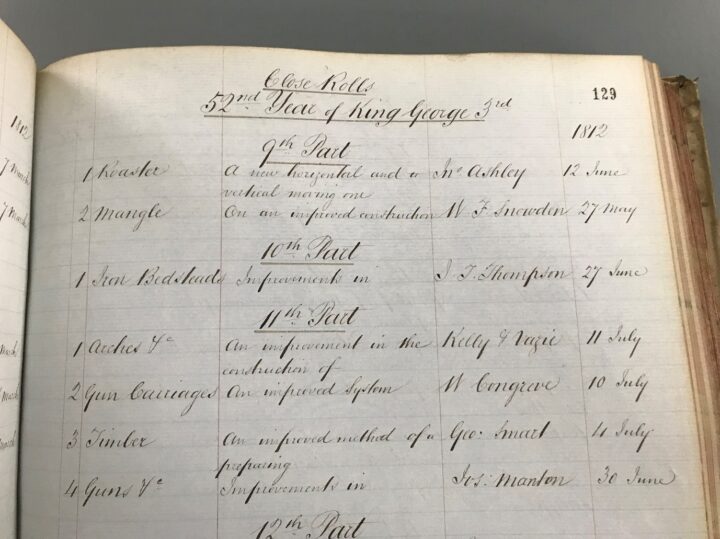
Specifications listed in index labelled ‘Refers to C 54, vol 160’, Specification and Close Rolls: Rolls of Chapel 1635-1848, Vol 1(IND 1/29432)
Indexed as “Roll’s Chapel reports”
For 1712-1802, lists of specifications in C 73 and C 54 were printed in the appendices of the Deputy Keeper’s reports, VI-VIII (1844-1846). The ‘Reference Index’ refers to the lists as ‘Roll’s Chapel Reports’.
A volume of lists compiled from the Deputy Keeper’s reports is on the open shelves in the reading room, labelled ‘Refers to C 54 etc., vol 163’ (red cover). Look for the relevant report number and page number within the volume.
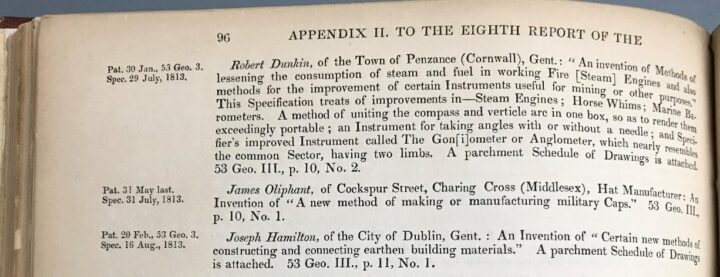
Specifications printed in appendix II of the Deputy Keeper’s report VIII and reproduced in the volume ‘Refers to C 54 etc., volume 163’
The volume has been arranged in two parts according to whether the specification appears in series C 73 or C 54. Specifications in C 73 have the modern reference written in red. C 54 entries must be converted, using the following steps:
- Note the old reference from the end of the description of the specification. It will look like this: ‘53. Geo. III, p.10, No.1’
- Note the date (including day and month) the specification was enrolled which is the second date in the margin
- Search in C 54 using the part number (p) and the year (you may need to convert from the regnal year)
- In your search results, check the date of the specification falls within the date range in your results
- The last number in the old reference format refers to the order of the specification on the roll
5. Other patent records
You can find other types of records relating to patents before October 1852 at The National Archives. Search our catalogue with keywords such as ‘patent’ or ‘invention’, restricted to departments BT, HO and SP.
Records include:
- Petitions for patents before 1782, with law officers’ reports, in State Papers Domestic. Search State Papers Online or use the entry books in SP 44
- Petitions for patents from 1782 onwards in HO 42, HO 44 and HO 45, with entry books in HO 43
- Warrants to law officers to draft patents of invention for 1783-1834 in HO 89
- Some reports by law officers, applications by patent agents and disputed cases, 1839-1885, in LO 1
6. Early patents of invention, with no specification
Most early patents give few details about the precise nature of the invention.
Try SO 7 from 1661. These bills, which authorised the issue of letters patent, sometimes include drawings of inventions.
Use the reference index (see section 3), which has an appendix giving abstracts from some early (1617-1745) applications for patents, where no separate specification was enrolled.
7. Records after October 1852
The National Archives generally does not hold patents or specifications after 1852. However, we hold many records relating to patents which include:
- Registered designs and trademarks
- Patent policy (BT 209)
- Some disputed patents (LO 4, J 99, J 105)
- Patents of interest to government departments such as the Admiralty (ADM 245) and the National Physical Laboratory (DSIR 10, DSIR 17)
- Disclaimers of specifications for 1857-1867 (C 54)
You can search these records in our catalogue using keywords. Most Patent Office records have the Board of Trade (BT) department code.
You can also browse the Patent Office division in our catalogue.
8. Scottish patents up to October 1852
Scotland had its own separate registration system for patents before 1853. Go to the National Records of Scotland for the records. However, we do hold some records of Scottish inventions in:
9. Irish patents up to October 1852
Ireland had its own separate registration system for patents before 1853, but the records no longer survive. However, you can find some records at The National Archives which refer to Irish patents in:
10. Further reading
‘British Patents of Invention, 1617-1977: A Guide for Researchers’ (British Library, 1999) by Stephen Van Dulken
Neil Davenport, ‘The United Kingdom Patent System: A Brief History’ (Kenneth Mason, 1979)
Sean Bottomley, ‘The British Patent System during the Industrial Revolution 1700-1852: From Privilege to Property’ (Cambridge, 2014)
Christine MacLeod, ‘Inventing the Industrial Revolution: The English Patent System, 1660-1800′ (Cambridge, 1988)
Appendix 1: Division codes in C 54
From the reign of Elizabeth I, the close rolls were divided into four, on a geographical basis, the B, Y, E and N divisions. The origins of this were probably related to the division of fees. The divisions were:
- B – Anglesey, Brecon, Cornwall, Carmarthen, Caernarvon, Devon, Glamorgan, Middlesex, Somerset, Surrey and the City of London.
- Y – Bedford, Chester, Derby, Dorset, Hertford, Lincoln, Nottingham, Northumberland, Oxford, Rutland, Stafford, Suffolk, Sussex, Warwick, Westmorland and Berwick upon Tweed.
- E – Berkshire, Buckinghamshire, Cardigan, Denbigh, Essex, Hampshire, Hereford, Kent, Monmouth, Pembroke, Wiltshire and Haverfordwest.
- N – Cambridge, Cumberland, Durham, Flint, Gloucester, Huntingdon, Lancaster, Leicester, Merioneth, Montgomery, Norfolk, Northampton, Radnor, Shropshire, Worcester and Yorkshire.
Appendix 2: Finding aid locations in the Map and Large Document Reading Room
The table lists the various finding aids with their National Archives’ references; the label on their spine, which gives the reference of the records they refer to; and the number of the shelf on which they can be found.
| Finding Aid | Label on spine | Shelf number |
|---|---|---|
| Bennett Woodcroft Patents of invention (6 volumes) | Ref bks 608.0202 WOO | H 8 |
| Close Rolls Charles I Surrender Rolls (IND 1/16938) | Refers to C 54 Vol 159 | D 1 |
| Specification and Close Rolls: Rolls of Chapel 1635-1848, Vol 1(IND 1/29432) | Refers to C 54 Vol 160 | D 1 |
| Specification 1848-1853, Enrolment Office, Chancery (C 275/207) | Refers to C 54 Vol 161 | D 1 |
| Specification 1853 and Disclaimers 1854-1866, Enrolment Office, Chancery (C 275/208) | Refers to C 54 Vol 162 | D 1 |
| Calendar of Specification Rolls (Rolls Chapel) 171 and Specifications (Close Rolls) 171 (red book) – compiled from Deputy Keeper’s Reports | Refers to C 54 Vol 163 | D 1 |
| Enrolment Office, Index 1617-1826 Vol 1 (C 275/209) | Refers to C 54 Vol 164 | D 1 |
| Enrolment Office, Index 1826-1845 Vol 2 (C 275/210) | Refers to C 54 Vol 165 | D 1 |
| Enrolment Office, Index 1846-1853, specifications; 1854-1858, disclaimers; Vol 3 (C 275/211) | Refers to C 54 Vol 166 | D 1 |
| Chancery Petty Bag Office, Specifications (IND 1/16941) | Refers to C 210 Vol 1 | D 23 |
| Chancery Petty Bag Office, Calendar of Specifications and Surrenders (IND 1/16942) | Refers to C 210 Vol 2 | D 23 |